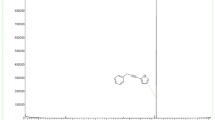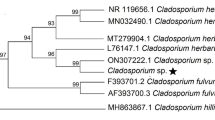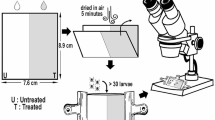Abstract
There is a growing interest in the use of botanical insecticides to reduce the use of synthetic pesticides in order to avoid environmental side effects. Anopheles stephensi is the primary vector of urban malaria, an endemic disease in India. So, an effort to assay An. stephensi larvae with gall extracts of Quercus infectoria was made under laboratory conditions at Mysore. Ethyl-acetate extract was found to be the most effective of all the five extracts tested for larvicidal activity against the fourth instar larvae, with LC50 of 116.92 ppm followed by gallotannin, n-butanol, acetone, and methanol with LC50 values of 124.62, 174.76, 299.26, and 364.61 ppm, respectively. The efficacy in killing mosquito larvae may make this plant promising for the development of new botanical larvicide.
Similar content being viewed by others
Introduction
Mosquito-transmitted diseases are the major cause of loss of human life worldwide, with over 700 million people suffering from these diseases annually (Taubes 1997). Malaria is one of the most serious health threats, even now, at national and international levels. Every year, an estimated 300–500 million new infections and 1–3 million deaths result from malaria worldwide (Muturi et al. 2008). From a global perspective the proportion of malaria cases has shifted slightly from Africa to the Asian continent (WHO 2005). In India, 1.67 million cases of malaria (including 0.77 million P. falciparum cases) and 1,487 deaths were reported in 2006 (NVBDCP 2008). Malaria impedes economic development not only by causing premature death but also through lost or diminished productivity, absenteeism, huge medical costs, and negative impact on fertility, population growth and country’s savings, and investments (Sachs and Malaney 2002). It is, therefore, not surprising that the gross domestic product of countries where malaria prospers is up to fivefold lower than in countries without severe malaria (Gallup and Sachs 2001). Increase in vector population may be explained by the changes in land use pattern or disturbance of the environment such as deforestation, aquaculture, agricultural development, etc. resulting in the accumulation of stagnant and brackish waters. Besides, such congenial conditions for the growth of mosquitoes have further been created by bad sanitation, lack of adequate disposal facilities, and unplanned growth of urban and rural sectors (Gubler 1998; WHO 2006).
Anopheles stephensi is an important vector of urban malaria in several countries of the Middle East and Indian subcontinent (Gayathri et al. 2006). Vector control remains the most effective measure to prevent malaria transmission and is, therefore, one of the four basic technical elements of the global malaria control strategy. The advantage of targeting the larval stages are that, mosquitoes are killed before they disperse to human habitations and that larvae, unlike adults cannot change their behavior to avoid control activities (Killeen et al. 2002). Nowadays, the control of vector-borne diseases is more difficult due to the increased resistance of mosquito populations to synthetic insecticides and even to microbial control agents and because of the resistance of malaria parasites to chemotherapic drugs and some economic issues (Hargreaves et al. 2000; Ranson et al. 2001; Gericke et al. 2002; Shelton 2007). Moreover, continuous application of insecticides poses serious threats to the environment in killing nontarget species such as larval predators, bioaccumulation, hampering biodiversity, and environmental pollution (Maurya et al. 2007).
It is imperative that new compounds and approaches be found to manage the malaria vectors better, and improved methods of control are urgently needed (Burfield and Reekie 2005). Indeed, the development of new or novel vector control agents, whether chemical or biological, which can reduce malaria morbidity and mortality rates would be a welcome addition to the arsenal against Anopheles mosquitoes. The development of alternative, ecofriendly, and sustainable approaches for mosquito control is with the use of natural phytoproducts owning greater target specificity and lower bioaccumulation properties (Sharma et al. 2006). So, researchers are now looking for natural insecticides which do not have any ill effects on nontarget population and are easily degradable. Thus, the search has been directed extensively to the plant kingdom as many plant chemicals have larvicidal, pupicidal, and adulticidal activities, most being repellants, ovipositional deterrents, and antifeedants against both agricultural pests and medically important insect species. It is in this context the present bioassay was carried out in the Vector Biology Research Lab of Zoology Department at University of Mysore.
Oak fruit was eaten by locals especially during food scarcity, and it is also used as folk medicine for treating some diseases (Umachigi et al. 2008). Its tanbark is also utilized in tannery by tribes to make goatskin. So, the present study was designed to identify whether oak gall extracts exhibit larvicidal activity also against An. stephensi mosquito.
Materials and methods
Gall extracts
Galls were collected from oak trees from the forests of Zagros mountains of Western Iran where the forests stretch up to about 2,000 m in altitude and form large areas of continuous cover. The galls result from the tumors provoked by the bite of female cynipid wasps in the buds of this plant (Tavakoli et al. 2008). The gall particles of Quercus infectoria are gray brown, globulous, with a surface coating of stout pointed spines containing many larval chambers. Their diameter is 1–2.5 cm. These were identified at the Lorestan Agricultural and Natural Resources Research Center, Khoramabad, Lorestan, Iran. Gall extracts were obtained following procedure of Redwane et al. (2002):
-
1.
Extraction by organic solvents: The pulverised galls (100 g) were subjected to solvent extraction in a Soxhlet extractor with chloroform. The defatted galls were then extracted with methanol. The methanolic solution was concentrated under reduced pressure, below 40°C, to dry and yielded 45.5 g (45.5%) of methanolic extract. The residue obtained was suspended in hot distilled water, supernatant decanted and the residue was sequentially extracted with ethyl ether, ethyl acetate, and n-butanol to yield 40 mg (0.04%), 560 mg (0.56%), and 2 g (2%) of each extract, respectively.
-
2.
Extraction of gallotannins: Powdered galls (40 g) were extracted twice with acetone at room temperature for 12 h and yielded 20 g (50%) of acetone extract after drying at room temperature. After evaporation of acetone from the residue, it was dissolved in mixture of distilled water and ethyl acetate (1:1) at room temperature for 24 h by using an ordinary magnetic spinner. The organic phases were dried over Na2SO4 and evaporated to give a mixture of gallotannins. Its yield was 1.5 g (3.8%).
Mosquito colony
The An. stephensi larvae were collected in April 2006 in and around Mysore city and maintained in an insectary at the Vector Biology Research Lab, Department of Studies in Zoology, University of Mysore, India. The adults were reared in cages (30 × 30 × 30 cm) fitted with mosquito netting and fed first on freshly water-soaked raisin. Water was provided via a wet cotton pad kept in a Petri plate. Female mosquitoes were allowed to feed on a mouse placed in resting cage overnight on the third day post-emergence. Small bowls filled with dechlorinated water and lined with filter paper were used to collect the eggs for hatching. The larvae were reared in large enamel or plastic trays (30 × 24 × 5 cm), containing dechlorinated water and fed with finely powdered dog biscuits and dry yeast in the ratio of 2:1. The food was sprinkled on the surface of the water twice daily. The rearing water was changed daily until pupation. Pupae were collected daily and transferred to small bowls containing dechlorinated water, by using a Pasteur pipette. The bowls were placed in cages for adult emergence. The test population was maintained in the laboratory under environmentally controlled conditions (26 ± 2°C and 70 ± 5% relative humidity) with a photo period of 14 h light and 10 h dark.
Larval bioassay
Bioassays on larvae were performed on late third or early fourth instars according to the standard procedure of WHO (WHO 1981). The required quantity of the respective gall extract of different concentrations in 1 ml of solvent was mixed thoroughly with 249 ml of water in 500 ml glass beakers. Larvae were exposed to an ascending series of five concentrations for each of the extract screened. Exposure concentrations varied depending on the extract but generally ranged from 100 to 1,000 mg/l. Parallel control tests were also maintained by adding 1 ml of respective solvent to 249 ml of dechlorinated water. Finally, 25 early fourth instar larvae were transferred to each beaker. A minimum of three replicates were kept for each concentration along with respective control. Tests were conducted for 24 h duration at 25°C and 12 h light/dark regime, then mortality was recorded.
The solvents used for dissolving the extracts were tested simultaneously as control. For acetone, ethyl acetate and gallotannin extracts, acetone was used as the dissolving agent for bioassay. Likewise for n-butanol and methanol extracts, methanol was used as the solvent. Some physicochemical parameters of the water such as pH, total alkalinity, total hardness, and dissolved oxygen were determined as per method of Trivedy and Goel (1986).
Data analysis
Larval counts were adjusted for the mortality in control, if present, employing Abbot’s formula to give an estimate of plant extract-attributable mortality. The corrected mortality data were subjected to regression analysis of probit-mortality on log dosage (Finney 1971).
Results
The results for the toxicity of the crude oak gall extracts by different solvents tested against An. stephensi larvae are presented in Table 1. The final solvent concentration, that is the highest exposure concentration, did not exceed 1/250 ml of water. This ensured that the solvents did not contribute to overall mortalities. Some physicochemical parameters of water were pH of 7–8; total alkalinity of 98 mg/l; total hardness of 506 mg/l, and dissolved oxygen of greater than 10 mg/l.
The organic extracts of oak gall were bioactive, but methanolic extract was least toxic of all extracts (LC50 = 364.61 mg/l), whereas ethyl-acetate was the most toxic one (LC50 = 116.92 mg/l). The LC50 of gallotannin, n-butanol, and acetone extracts were 124.62, 174.76, and 299.26 mg/l, respectively. The log dose–probit mortality responses of all extracts are provided in Fig. 1. The ethyl acetate extract showed 7.0% and 94.0% mortality at 85 and 145 ppm, respectively. Similarly, gallotannin caused 9.0% and 88.0% mortality at 106 and 140 ppm, respectively; followed by n-butanol with 11.0% and 91.0% mortality values at 150 and 210 ppm, respectively. Acetone extract induced 10.0% and 90.0% mortality at 246 and 350 ppm, respectively, whereas, methanolic extract showed the least efficacy with 10.5% and 95.0% mortality at 190 and 1,000 ppm, respectively.
Discussion
Out of the five organic solvent extracts from oak gall, significant larvicidal activity against An. stephensi was observed with ethyl acetate (LC50 = 116.92), followed by gallotannin, n-butanol, acetone and methanol (P < 0.05). The type of solvent selected affects extract efficacy because different phytochemicals of varying volatility are present in the final extraction (Shaalan et al. 2005). Different solvents are used in plant extracts screening since polar solvents extract polar molecules and nonpolar solvents extract nonpolar molecules. The purpose of a general screening for bioactivity is to extract as many potentially active constituents as possible. This is achieved by using solvents ranging from water, the most polar one with a polarity index (P) of 10.2 to hexane (nonpolar; P = 0.1) including a number of intermediary solvents such as methanol (P = 6.1), acetone (P = 5.1), ethyl acetate (P = 4.4), and n-butanol (P = 3.9) (Shaalan et al. 2005). Data on gall extracts show that a converse relationship is observed between extract efficacy and solvent polarity where efficacy increases with decreasing polarity. This is in line with the observations made by Mulla and Su (1999) in neem plant extracts. However, this is not consistent due to differences between the characteristics of active chemicals among plants. Similarly, ethanol extracts of both Haplophyllum tuberculaturn and Ruta graveolens (LC50 of 20 and 230 ppm, respectively) were more toxic than petroleum ether extract (LC50 of 87 and 380 ppm, respectively) against Cx. Pipiens (Shaalan et al. 2005).
Perusal of literature shows that, Redwane et al. (2002) have done an earlier experiment in Morocco with oak gall extracts against larvae of Cx. pipiens and found the LC50 values to be 2,000, 1,698, 1,531, 556, and 373 ppm for n-butanol, methanol, ethyl acetate, acetone, and gallotannin extracts, respectively. In contrast to that, the present bioassay shows much more efficacy of gall extract on An. stephensi. Larvicidal activities of plant extracts can be observed to vary by species of plants and mosquitoes, the parts of the plant, the geographical location where the plants were grown, and the application method (Sukumar et al. 1991), which is in line with the present result.
The arsenal of safe and cost-effective insecticides is severely depleted, mainly because of the development of resistance in major vectors to common insecticides on one hand, and due to the adverse qualities of chemical insecticides on the other (Zaim and Guillet 2002). So, it is imperative to find and develop effective, safe, readily biodegradable, easily available, and also cost-effective insecticides as a part of integrated vector management. Furthermore, different intervention measures need to be applied selectively, with due regard to existing local conditions. In this regard, oak gall is found to be a remarkable, economical, and environmentally friendly with mosquito larvicidal properties. So, it could form a new source for managing mosquito larvae. Therefore, its bioactive components should be explored through further investigations as this plant grows abundantly in the wild.
References
Burfield T, Reekie SL (2005) Mosquitoes, malaria and essential oils. Int J Aroma 15:30–41
Finney DJ (1971) Probit Analysis, 3rd edn. Cambridge University Press, Cambridge
Gallup JL, Sachs JD (2001) The economic burden of malaria. Am J Trop Med Hyg 64:85–96
Gayathri V, Balakrishna Murthy P (2006) Reduced susceptibility to deltamethrin and kdr mutation in Anopheles stephensi Liston, a malaria vector in India. J Am Mosq Cont Assoc 22:678–688
Gericke A, Govere JM, Durrheim DN (2002) Insecticide susceptibility in the South African malaria mosquito Anopheles arabiensis (Diptera: Culicidae). S Afr J Sc 98:205–208
Gubler DJ (1998) Resurgent vector-borne diseases as a global health problem. Emerg Infect Dis 4:442–450
Hargreaves K, Koekemoer LL, Brooke BD, Hunt RH, Mthembu J, Coetzee M (2000) Anopheles funestus resistant to pyrethroid insecticides in South Africa. Med Vet Entomol 14:181–189
Killeen GF, Fillinger U, Knols BG (2002) Advantages of larval control for African malaria vectors: low mobility and behavioural responsiveness of immature mosquito stages allow high effective coverage. Malar J 1:8
Maurya P, Mohan L, Sharma P, Batabyal L, Srivastava CN (2007) Larvicidal efficacy of Aloe barbadensis and Cannabis sativa against the malaria vector Anopheles stephensi (Diptera: Culicidae). Entomol Res 37:153–156
Mulla MS, Su T (1999) Activity and biological effects of neem products against arthropods of medical and veterinary importance. J Am Mosq Cont Assoc 15:133–152
Muturi EJ, Burgess P, Novak RJ (2008) Malaria vector management: where have we come from and where are we headed? Am J Trop Med Hyg 78:536–537
National Vector Borne Disease Control Programme (NVBDCP) (2008) Malaria, magnitude of the problem. Available at http://www.nvbdcp.gov.in/malaria3.html Accessed on May 25, 2008
Ranson H, Rossiter L, Ortelli F, Jensen B, Wang X, Roth CW, Collins FH, Hemingway J (2001) Identification of a novel class of insect glutathione S-transferases involved in resistance to DDT in the malaria vector, Anopheles gambie. Biochem J 359:295–304
Redwane A, Lazrek HB, Bouallam S, Markouk M, Amarouch H, Jana M (2002) Larvicidal activity of extracts from Quercus lusitania var. infectoria galls (Oliv.). J Ethnopharmacol 79:261–263
Sachs J, Malaney P (2002) The economic and social burden of malaria. Nature 415:680–685
Shaalan EA, Canyon D, Younes MW, Abdel-Wahab H, Mansour AH (2005) A review of botanical phytochemicals with mosquitocidal potential. Environ Int 31:1149–1166
Sharma P, Mohan L, Srivastava CN (2006) Impact analysis of neem kernel extracts on the developmental profile of Anopheles stephensi. J Asia Pac Entomol 9:11–17
Shelton AM, Wang P, Zhao J-Z, Roush RT (2007) Resistance to insect pathogens and strategies to manage resistance: An update. In: Laceyand LA, Kaya HK (eds) Field Manual of Techniques in Invertebrate Pathology. Springer-Verlag, New York
Sukumar K, Perich MJ, Boobar LR (1991) Botanical derivatives in mosquito control: a review. J Am Mosq Cont Assoc 7:210–237
Taubes G (1997) A mosquito bites back. New York Times Magazine 24 Aug: 40–46
Tavakoli M, Melika G, Sadeghi SE, Penzes Z, Assareh MA, Atkinson R, Bechtol M, Miko I, Zargaran MR, Aligolizade D, Barimani H, Bihari P, Pirozi F, Fulop D, Somogyi K, Challis R, Preuss S, Nicholls J, Stone GN (2008) New species of oak gall wasps from Iran (Hymenoptera: Cynipidae: Cynipini). Zootaxa 1699:1–64
Trivedy RK, Goel PK (1986) Chemical and biological methods for water pollution studies. Environmental Publications, Karad
Umachigi SP, Jayaveera KN, Ashok Kumar CK, Kumar GS, Vrushabendra swamy BM, Kishore Kumar DV (2008) Studies on wound healing properties of Quercus Infectoria. Trop J Pharm Res 7:913–919
World Health Organization (1981) Instructions for determining the susceptibility or resistance of mosquito larvae to insecticides. WHO, Geneva WHO/VBC/81.807
World Health Organization (2005) World malaria report 2005. WHO, Geneva Available at www.rollbackmalaria.org/wmr2005/pdf/WMReport_lr.pdf
World Health Organization study group (2006) Malaria vector control and personal protection. WHO Tech Rep Ser 936:1–62
Zaim M, Guillet P (2002) Alternative insecticides: an urgent need. Trends Parasitol 18:161–163
Acknowledgement
The authors are grateful to the Chairman, DOS in Zoology, University of Mysore, for providing necessary facilities. We also kindly thank Mr. Majid Tavakoli, researcher, Lorestan Agricultural and Natural Resources Research Center, Khoramabad, Lorestan, Iran, for collecting, identifying, and providing oak gall samples. First author is thankful to Ilam Medical Sciences University, Iran, for financial support.
Author information
Authors and Affiliations
Corresponding author
Rights and permissions
About this article
Cite this article
Aivazi, AA., Vijayan, V.A. Larvicidal activity of oak Quercus infectoria Oliv. (Fagaceae) gall extracts against Anopheles stephensi Liston. Parasitol Res 104, 1289–1293 (2009). https://doi.org/10.1007/s00436-008-1325-5
Received:
Accepted:
Published:
Issue Date:
DOI: https://doi.org/10.1007/s00436-008-1325-5





